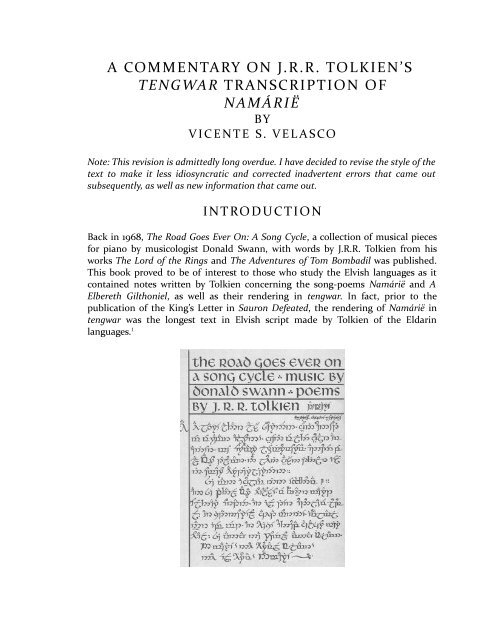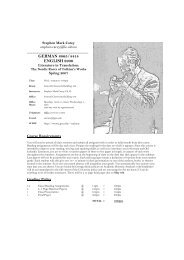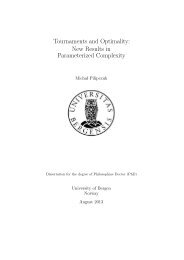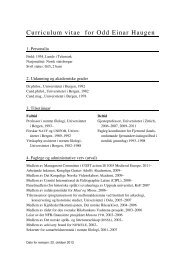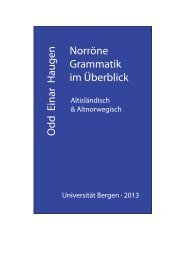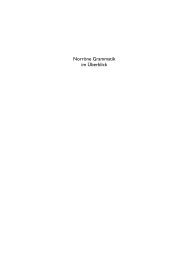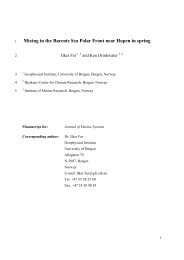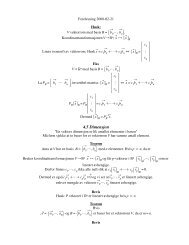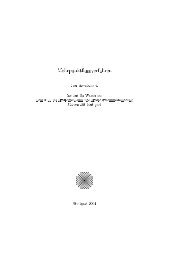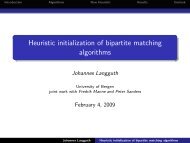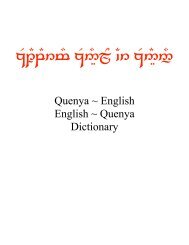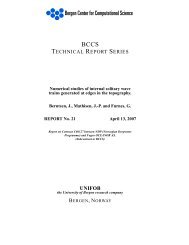a commentary on jrr tolkien's tengwar transcription of
a commentary on jrr tolkien's tengwar transcription of
a commentary on jrr tolkien's tengwar transcription of
Create successful ePaper yourself
Turn your PDF publications into a flip-book with our unique Google optimized e-Paper software.
A COMMENTARY ON J.R.R. TOLKIEN’S<br />
TENGWAR TRANSCRIPTION OF<br />
NAMÁRIË<br />
BY<br />
V I C E N T E S . V E L A S CO<br />
Note: This revisi<strong>on</strong> is admittedly l<strong>on</strong>g overdue. I have decided to revise the style <strong>of</strong> the<br />
text to make it less idiosyncratic and corrected inadvertent errors that came out<br />
subsequently, as well as new informati<strong>on</strong> that came out.<br />
INTRO DUCTION<br />
Back in 1968, The Road Goes Ever On: A S<strong>on</strong>g Cycle, a collecti<strong>on</strong> <strong>of</strong> musical pieces<br />
for piano by musicologist D<strong>on</strong>ald Swann, with words by J.R.R. Tolkien from his<br />
works The Lord <strong>of</strong> the Rings and The Adventures <strong>of</strong> Tom Bombadil was published.<br />
This book proved to be <strong>of</strong> interest to those who study the Elvish languages as it<br />
c<strong>on</strong>tained notes written by Tolkien c<strong>on</strong>cerning the s<strong>on</strong>g-poems Namárië and A<br />
Elbereth Gilth<strong>on</strong>iel, as well as their rendering in <strong>tengwar</strong>. In fact, prior to the<br />
publicati<strong>on</strong> <strong>of</strong> the King’s Letter in Saur<strong>on</strong> Defeated, the rendering <strong>of</strong> Namárië in<br />
<strong>tengwar</strong> was the l<strong>on</strong>gest text in Elvish script made by Tolkien <strong>of</strong> the Eldarin<br />
languages. 1
Nevertheless, the <strong>tengwar</strong> versi<strong>on</strong> <strong>of</strong> Namárië is the l<strong>on</strong>gest text in Quenya<br />
written in <strong>tengwar</strong> by Tolkien himself. The dust jacket <strong>of</strong> The Road Goes Ever On is<br />
comprised <strong>of</strong> Namárië <strong>on</strong> the fr<strong>on</strong>t cover (as illustrated above), 2 and A Elbereth<br />
Gilth<strong>on</strong>iel at the back. Within the book itself, the <strong>tengwar</strong> texts can be found in<br />
pages 57 and 62.<br />
Although Tolkien’s text is readable, I have decided to render the text using<br />
Johann Winge’s Tengwar Annatar TrueType f<strong>on</strong>t for better clarity, as it gives the best<br />
approximati<strong>on</strong> <strong>of</strong> Tolkien’s style more than closely than any other f<strong>on</strong>t available. 3<br />
However, for the title NAMÁRIË itself, I used Dan Smith’s Tengwar Noldorin f<strong>on</strong>t.
For reference, here is its transliterati<strong>on</strong>, corresp<strong>on</strong>ding to the words <strong>of</strong> the<br />
Tengwar versi<strong>on</strong>.<br />
NAMÁRIË<br />
Altariello nainië Loriendesse<br />
Ai laurië lantar lassi súrinen · yéni únótime ve<br />
rámar aldar<strong>on</strong>! · Yéni ve linte yuldar avánier ·<br />
mí oromardi lissemiruvóreva · Andúne pella Vardo<br />
tellumar · nu luini yassen tintilar i eleni ·<br />
ómaryo airitárilírinen ::<br />
Sí man i yulma nin enquantuva? ::<br />
An sí Tintalle Varda Oiolossëo · ve fanyar máryat<br />
Elentári ortane · ar ilye tier unduláve lumbule ·<br />
ar sindanóriello caita mornie · i falmalinnar<br />
imbe met · ar hísie untúpa Calaciryo míri oiale: sí<br />
vanwa ná Rómello vanwa Valimar!<br />
Namárië! Nai hiruvalye Valimar!<br />
Nai elye hiruva! Namárië ::<br />
Helge Fauskanger had already written an excellent line-by-line exegesis <strong>of</strong> Namárië<br />
in his Ardalambi<strong>on</strong> website, 4 so I deem it unnecessary to repeat much <strong>of</strong> it here.<br />
However, delving in etymological analysis in many instances is inadvertent, if <strong>on</strong>ly<br />
to prove point or justificati<strong>on</strong>. Therefore, this <str<strong>on</strong>g>commentary</str<strong>on</strong>g> can be regarded as<br />
supplement to Helge’s article.<br />
It is assumed that the reader is familiar with Appendix E <strong>of</strong> The Lord <strong>of</strong> the Rings,<br />
in particular the forms <strong>of</strong> the <strong>tengwar</strong> and their corresp<strong>on</strong>ding names, and their<br />
values in Quenya.<br />
CO M M E N TA RY<br />
Namárië: The word, as rendered in Tengwar, already tells us three things: first, that<br />
in Quenya the tengwa (c<strong>on</strong>s<strong>on</strong>ant letter) is written first, then the following vowel<br />
sign or diacritic (ómatehta) is written above the c<strong>on</strong>s<strong>on</strong>ant. Therefore to Quenya in<br />
Tengwar script <strong>on</strong>e would read each tengwa, then the ómatehta above it (in an upward<br />
moti<strong>on</strong>), before proceeding to the next tengwa/ómatehta combinati<strong>on</strong>.<br />
Sec<strong>on</strong>d, whenever a l<strong>on</strong>g vowel follows the tengwa, as in the case <strong>of</strong> the sec<strong>on</strong>d a<br />
in Namárië, this is written as an ómatehta over a single l<strong>on</strong>g carrier, which is the<br />
usually the preferred way to write it. For an alternate way to express a l<strong>on</strong>g vowel,<br />
see <str<strong>on</strong>g>commentary</str<strong>on</strong>g> under the entry yéni.
Third, in the case <strong>of</strong> dissyllabic vocalic clusters as in -ie the first ómatehta is written<br />
above the preceding tengwa, and then the next vowel sign is written above a single<br />
short carrier.<br />
Altariello: Because this word begins with a vowel, the Tengwar script versi<strong>on</strong> begins<br />
with the vowel diacritic for a written above a short carrier. Note that in the original<br />
versi<strong>on</strong> the a-diacritic is simplified to look like a circumflex.<br />
The obvious reas<strong>on</strong> for this is that writing three dots with a nib pen would be difficult<br />
if <strong>on</strong>e is writing small letters and even smaller diacritics; but Tolkien also<br />
wrote that this practice was comm<strong>on</strong> am<strong>on</strong>g scribes because the a-sound occurs so<br />
frequently that writing the simplified form is much more c<strong>on</strong>venient, especially if<br />
<strong>on</strong>e is in a hurry — or if no c<strong>on</strong>fusi<strong>on</strong> would occur, eliminated altogether. Tolkien<br />
gives the word calma “lamp” as an example: <strong>on</strong>e can actually dispense with writing<br />
the a-diacritic altogether (ajt), because the word calama does not exist.<br />
It is also in this word that we first encounter the use <strong>of</strong> the under-stroke under a<br />
tengwa to indicate that the c<strong>on</strong>s<strong>on</strong>ant is doubled: j° = ll. 5<br />
nainië: This word illustrates that diphth<strong>on</strong>gs — in this case ai — are written by<br />
writing the preceding vowel sign over the following semi-vowel tengwa, in this case<br />
the tengwa yanta. Such is also the case with the interjecti<strong>on</strong> ai! But not always so;<br />
see the ommentary under caita. See also laurië.<br />
laurië: As in the entry nainië above, the diphth<strong>on</strong>g au is written with thevowel sign<br />
for a above the semi-vowel tengwa úre.<br />
lantar: This is the first time that <strong>on</strong>e encounters the tengwa óre representing r,<br />
whereas r in the words Namárië, Lóriendesse and laurie above is represented by<br />
rómen. The latter letter is a modificati<strong>on</strong> <strong>of</strong> óre, used originally to represent a trilled<br />
r, while óre was used to represent a weak (untrilled) r, originally occurring in Quenya.<br />
However, as Tolkien noted, this distincti<strong>on</strong> was later lost, and the r-sound is<br />
trilled in all positi<strong>on</strong>s and not lost pre-c<strong>on</strong>s<strong>on</strong>antally. In theory, therefore, <strong>on</strong>e can<br />
use either óre or rómen to represent r in any positi<strong>on</strong>, but in practice am<strong>on</strong>g scribes<br />
to use óre to represent pre-c<strong>on</strong>s<strong>on</strong>antal and final r, while rómen is used to represent<br />
intervocalic r. 6<br />
lassi: Note here that Tolkien used the usual ómatehta for e to represent i in this<br />
case. Although this is allowed, the use <strong>of</strong> <strong>on</strong>e or the other should be c<strong>on</strong>sistent<br />
throughout.<br />
súrinen: I have written before that the s in súrinen should have been rendered with<br />
the tengwa súle (older thúle), not silme. I had made this assumpti<strong>on</strong> because <strong>of</strong> the<br />
existence <strong>of</strong> the root THŪ “blow”. 7 However, it turns out that there exists a variant<br />
stem SŪ “wind”, 8 therefore the use <strong>of</strong> silme is indeed correct.<br />
Yéni: This is the first time <strong>on</strong>e encounters the tengwa anna with y-diacritic written<br />
below the letter to represent c<strong>on</strong>s<strong>on</strong>antal y. The tengwa anna does have any value in<br />
Quenya though in early Quenya it had the value <strong>of</strong> the back spirant ʒ, which later<br />
became lost. 9 But by the Third Age this had the value <strong>of</strong> c<strong>on</strong>s<strong>on</strong>antal y when combined<br />
with the y-diacritic: hÎ.
The other way to write a l<strong>on</strong>g vowel in diacritic-style <strong>tengwar</strong> is to write the vowel<br />
twice over the preceding tengwa. This is usually practiced when writing l<strong>on</strong>g e, less<br />
usual when writing l<strong>on</strong>g o and u (as in the Ring-inscripti<strong>on</strong>), but never with a and i.<br />
But in the other occurrence <strong>of</strong> yéni in the poem, Tolkien wrote l<strong>on</strong>g e by using the<br />
l<strong>on</strong>g carrier.<br />
únótime: This word, like Altariello above, begins with a vowel, but this time, beginning<br />
with a l<strong>on</strong>g carrier.<br />
ve: The use <strong>of</strong> the tengwa vala here suggests that it descended from a primitive form<br />
*bē. However, Tolkien variously derived ve from wē or vai as well. 10<br />
rámar: The l<strong>on</strong>g carrier in this case (indicating that the a above the tengwa rómen<br />
is l<strong>on</strong>g) can be seen below the letter.<br />
avánier: The word avánier is the plural perfect form <strong>of</strong> the verb auta- “go away,<br />
leave (the point <strong>of</strong> the speaker’s thought)”; in turn this is descended from the root<br />
AWA. 11 So it stands to reas<strong>on</strong> then that the v in avánier, written with the tengwa vala<br />
(said to represent v that descended from primitive b), should instead be written<br />
with the tengwa vilya (v from primitive w, though it still represents w when it occurs<br />
in later Quenya), thus: `Cn~C5G`F6. 12<br />
mí: As in lassi above, Tolkien used the ómatehta that usually represents e.<br />
lisse-miruvóreva: It has been determined that the possessive-adjective suffix -va is<br />
an allomorphic form <strong>of</strong> -wa as in hwesta sindarinwa. Therefore the v here should be<br />
written with a vilya: t%7Uy~NnE.<br />
luini: Note here that the diphth<strong>on</strong>g ui is written with the ómatehta for u above the<br />
semi-vowel tengwa yanta.<br />
ómaryo: Note here that Tolkien omitted the y-diacritic below the tengwa rómen<br />
(which he repeated in maryat).<br />
enquantuva: The ph<strong>on</strong>eme nqu (nkw) is written with the tengwa unque. While this<br />
may be correct, it is my opini<strong>on</strong> that it should be written with a númen and a<br />
quesse.The reas<strong>on</strong> for this is in order for the reader to be aware that enquantuva is a<br />
compound <strong>of</strong> en- “re-, again” and quantuva, the future tense form <strong>of</strong> quanta- “fill”. 13<br />
The use <strong>of</strong> two <strong>tengwar</strong> instead <strong>of</strong> <strong>on</strong>e preserves this c<strong>on</strong>structi<strong>on</strong>, thus: `F5zE4&yE.<br />
The use <strong>of</strong> vala in enquantuva suggests that the future tense suffix –uva has *-ubā<br />
as its ulterior form. 14<br />
Oiolossëo: The diphth<strong>on</strong>g oi is written with the ómatehta for o above the semivowel<br />
tengwa yanta.<br />
ar: This suggests — and c<strong>on</strong>firmed in later published material — that the c<strong>on</strong>juncti<strong>on</strong><br />
is descended from Comm<strong>on</strong> Eldarin AS. 15<br />
sindanóriello: Note here that Tolkien used the tengwa silme nuquerna to represent<br />
s. This is <strong>of</strong>ten used to accommodate tehtar written above the letter when it otherwise<br />
cannot be seen or discerned if the normal form <strong>of</strong> silme is used. However,<br />
silme should not have been used— nuquerna or otherwise — to represent s; the<br />
word sinda or sinde is derived from the base THIN-, thus the use <strong>of</strong> súle/thúle instead<br />
<strong>of</strong> silme in this case: 3G2#5~N7T`Vj° H.
caita: Note here that the diphth<strong>on</strong>g ai in this case is written with the a-diacritic<br />
above the tengwa calma, followed by the semi-vowel yanta.<br />
hísie: The s here should not be written with a silme (or again in this case, a silme<br />
nuquerna), but rather with a súle/thúle, as the word hísie (S. hith) is descended from<br />
a base KHITH- (cf. Hísime = S. Hithui, the name <strong>of</strong> the eleventh m<strong>on</strong>th <strong>of</strong> the<br />
Númenórean calendar). Thus it should be rendered as 9~B3B`V. 16<br />
vanwa: Like avánier above, this is derived from AWA. Therefore the v should be<br />
written with a vilya, not a vala, thus: nE5nE. Note also that Tolkien used the <strong>tengwar</strong><br />
númen and vilya to represent the diagraph nw. One could have used the tengwa<br />
nwalme instead, but strictly speaking, this can <strong>on</strong>ly be used to represent the sound<br />
ñw (< *ŋgw).<br />
Aside from this, note also that Tolkien used “Quenya capitals” when writing proper<br />
nouns such as Varda, Oiolosse, Andúne, Rómen, Valimar. It is also in this poem that<br />
some Tengwar punctuati<strong>on</strong> marks have become known for the first time. Tolkien<br />
used the symbol À to represent the query mark, and Á to represent the exclamati<strong>on</strong><br />
point.<br />
NOTES<br />
1 Facsimiles <strong>of</strong> the letter (both in diacritic mode and in the Mode <strong>of</strong> Beleriand (MoB)) can be<br />
found in IX:130-131. But I would like to take this opportunity to comment <strong>on</strong> this transcripti<strong>on</strong> as<br />
well: in the <strong>tengwar</strong> versi<strong>on</strong> <strong>of</strong> A Elbereth Gilth<strong>on</strong>iel (using the Mode <strong>of</strong> Beleriand) as well as the<br />
Moria-gate inscripti<strong>on</strong>, 6 represents n (5 being nn), but in the MoB versi<strong>on</strong> <strong>of</strong> the King’s Letter,<br />
6 was used to represent r as well, thus ljlk]6 = Elessar.<br />
2 The dust cover is a scan <strong>of</strong> the First Editi<strong>on</strong>. The Sec<strong>on</strong>d and Third Editi<strong>on</strong>s have a different color<br />
scheme and appearance but retain the <strong>tengwar</strong> text. It must be noted that the page references in<br />
this article are <strong>of</strong> the First Editi<strong>on</strong>.<br />
3 In the first versi<strong>on</strong> <strong>of</strong> my rendering <strong>of</strong> the text, I used Måns Björkman’s Tengwar Parmaite f<strong>on</strong>t as<br />
Johann Winge’s f<strong>on</strong>t was <strong>of</strong> yet unavailable. The editors <strong>of</strong> Vinyar Tengwar likewise use Winge’s<br />
f<strong>on</strong>t.<br />
4 The URL is http://www.uib.no/People/hnohf/namarie.htm.<br />
5 Compare this to the Moria-gate inscripti<strong>on</strong>, where ll is rendered as two lambi as seen in mell<strong>on</strong><br />
“friend”: yljjh6.<br />
6 But strangely enough, if <strong>on</strong>e would write the word óre in <strong>tengwar</strong>, rómen is used to represent r,<br />
and not the tengwa óre! See The Lord <strong>of</strong> the Rings p. 1088 s.v. R, and ibid. pp. 1094 and 1095.<br />
7 See V:393, s.v. THŪ.<br />
8 See VT47:35.<br />
9 See esp. VT39:17 note 2.<br />
10 See VT49:10,32 and PE17:189.<br />
11 See XI:366.
12 Tolkien wrote: “Both v and w are used in the transcripti<strong>on</strong> <strong>of</strong> Quenya, in spite <strong>of</strong> the assimilati<strong>on</strong><br />
<strong>of</strong> its spelling in Latin, since the two sounds, distinct in origin, both occurred in the language.”<br />
The Lord <strong>of</strong> the Rings p. 1088 s.v. W.<br />
13 Both the verbs quanta- and quat- coexist to mean fill, the former the verbal derivative <strong>of</strong> the adjectival<br />
form quanta “full, filled”. Furthermore it seems that quanta- is the more usual form <strong>of</strong> the<br />
verb. See PE17:68.<br />
14 This is c<strong>on</strong>firmed in VT48:32, c<strong>on</strong>tinuati<strong>on</strong> <strong>of</strong> note 15, wherein the future suffix –uva is sometimes<br />
(but not always associated) with a base UB “have in mind”.<br />
15 See VT43:30. Also VT47:31, note 44 and VT48:32, c<strong>on</strong>tinuati<strong>on</strong> <strong>of</strong> note 15.<br />
16 This opini<strong>on</strong> is shared by Jim Allan and many other scholars. See for example, An Introducti<strong>on</strong> to<br />
Elvish, p. 244.


